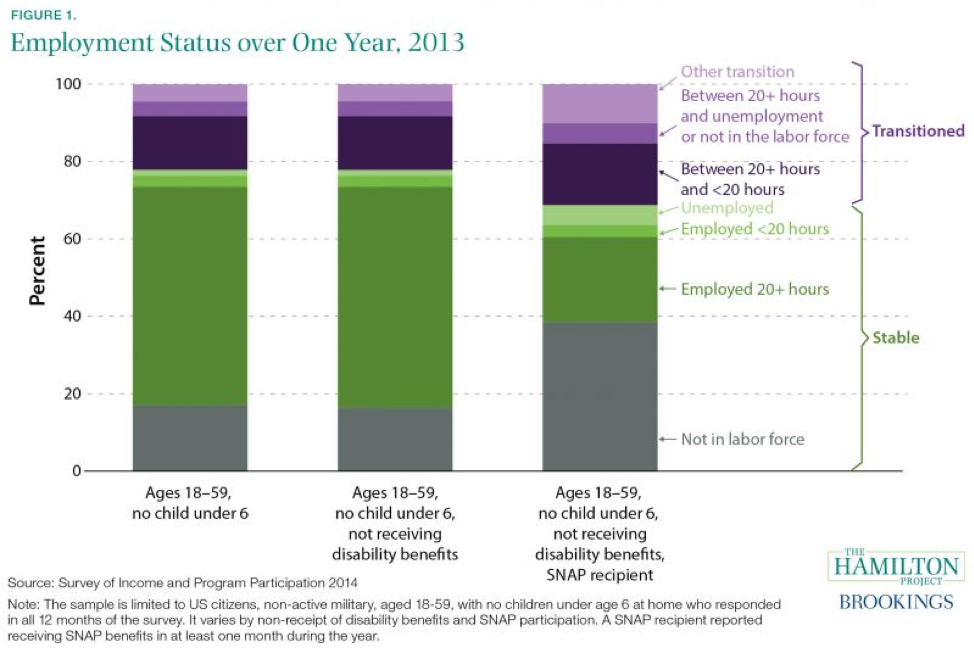Last month, President Donald Trump‘s Council of Economic Advisors issued a 64-page report calling for both new and stronger work requirements for participants in non-cash welfare programs such as the Supplemental Nutrition Assistance Program and Medicaid. In the weeks since the report was issued, the Trump administration approved Medicaid work requirements in several states, and congressional allies in the House of Representatives passed a 2018 farm bill that would subject more SNAP recipients to work requirements.
As the long-running debate over whether work requirements do, in fact, benefit low-income recipients of federal benefits rages on, a new report from the Hamilton Project at the Brookings Institution serves as a timely reminder that most participants in one prominent (and frequently targeted) federal program—SNAP—already do work. Many of these adults, however, transition frequently between working more than 20 hours a week (the minimum number of working hours required for SNAP eligibility in the House’s proposed legislation), working less than 20 hours a week, being unemployed, or being out of the labor force altogether.
Using data from the federal Survey of Income and Program Participation, researchers Lauren Bauer and Diane Whitmore Schanzenbach found that “approximately 18 percent of adults 18 to 59 without a child under the age of 6 switched between working more than 20 hours per week and another employment status.” Among SNAP recipients, 21 percent oscillated between working at least 20 hours per week and falling into a different employment status. The chart below illustrates the employment status of three different demographic groups: adults aged 18 to 59, without a young child; adults aged 18 to 59, without a young child, not receiving disability benefits; and SNAP recipients aged 18 to 59, without a young child, not receiving disability benefits.

Among SNAP recipients, over 60 percent were in the labor force, but more than 30 percent transitioned between different employment statuses during the year; 21 percent transitioned between working more than 20 hours a week and a different employment status. Only 22 percent were stably working more than 20 hours a week.
This instability, which echoes the findings of a recent report released by the Center on Budget and Policy Priorities, means that many working SNAP recipients would be at risk of losing their benefits under the terms proposed by House Republicans. “Because only those working more than 20 hours per week every month would be eligible to retain their SNAP benefits,” Bauer and Schanzenbach write, “we estimate that nearly 80 percent of adults without children under 6 at home who do not receive disability benefits would be exposed to potential SNAP benefit loss under the House work requirements proposal.”
Bauer and Schanzenbach’s report also explores the reasons as to why SNAP recipients work less than 20 hours a week. Among adult SNAP recipients (not receiving a disability payment) neither working nor looking for work, 65 percent said they weren’t working due to some kind of health issue or physical disability. Thirteen percent were students, and another 7 percent cited caregiving responsibilities. Among SNAP recipients who were in the labor force but did not consistently work 20 hours a week, 41 percent cited a work-related reason for working less than 20 hours a week (they couldn’t find work, were laid off, or worked for no pay at a family business for at least 15 hours a week); 12 percent cited a health-related explanation.
The fate of the changes to SNAP’s work requirements proposed by House Republicans is currently unclear—the Senate’s version of the 2018 farm bill does not contain dramatic changes to SNAP work requirements.




